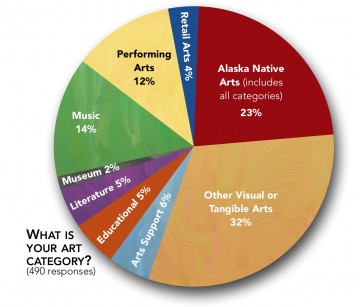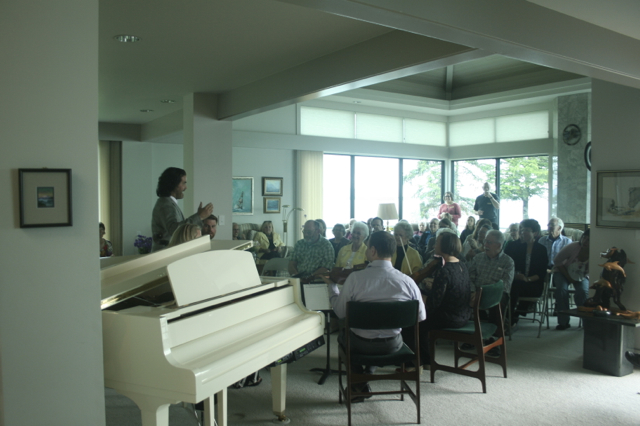
The Sitka Summer Music Festival is part of Southeast Alaska’s arts economy, which generated about $60 million in spending in 2013. Here, Artistic Director Zuill Bailey explains some musical backstories at 2014’s final concert. (KCAW photo/Greta Mart)
What are the arts worth to Southeast Alaska?
A new economic study says painting, carving, theater, music and other creative pursuits generate at least $60 million a year in business.
“When you’re looking at the saturation of artists in the region, we have nearly three times as many of the general U.S. population,” says Meilani Schijvens, director of Juneau-based Rain Coast Data.
In a report prepared for the Southeast Conference, she estimates 2,340 artists live and work in the region. Many do it part-time, but their hours add up to the equivalent of 2.5 percent of workforce.

Southeast artists include musicians, actors, carvers, painters and educators. (Chart courtesy Rain Coast Data/Southeast Conference)
“Last year, Southeast Alaska artists earned nearly $30 million, just from the arts components of their job,” she says. “And to put this in context, in terms of workforce earnings, the arts sector is nearly twice the size of the regional timber industry.”
It’s also about the same size as Southeast’s financial sector, including banks, investment firms and so on, based on full-time equivalent jobs.
Schijvens says about one in 10 of those surveyed make their entire living in the arts. About six in 10 earn less. And some don’t make any money at all.
“Thirty percent of artists in the region, while accepting money for their work, are actually losing money. So nearly a third of the artists are actually spending more in terms of investing in their artwork than they get paid for doing their art,” Schijvens says.
The total regional arts revenue adds up to almost $60 million a year. That includes spending by artists, customers, organizations and audience members.
“It stimulates business activities. It generates tourism revenue. It attracts and retains a high-quality workforce here. People come here because of our arts community and arts our region has to offer. They stay here because of that. And it boosts quality of life,” she says.
Schijvens says her research shows that Tlingit, Haida and other Alaska Native artists make more money. Twice as many, just under 20 percent, generate all their income from the arts.
“If you look at the average net profit for independent Native artists, it’s 64 percent higher than the average net profit for all Southeast Alaska independent artists,” Schijvens says.
The figures come from surveys of regional artists and organizations. Schijvens says the numbers, spending and earnings are probably larger, since she didn’t reach everyone who could have responded.
The researcher hopes the data will be useful for groups seeking grants or looking for ways to collaborate.
“As a whole, we’re stronger than the sum of our parts. So I hope the artists and arts organizations in the region will come together to be able to leverage more grant funding, be able to do more marketing, let people know what a treasure we have and to be able to take advantage of the larger network of art and artists that we have,” she says.
The report was first presented to the Southeast Conference, an organization of business, government and other leaders promoting economic development in the region.































